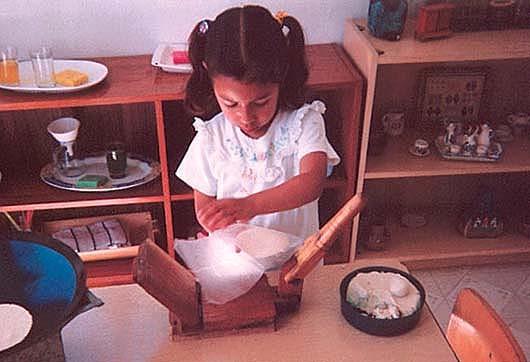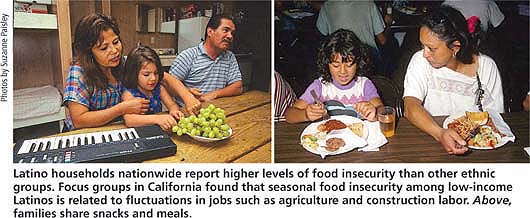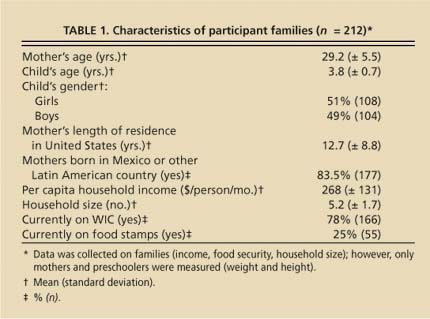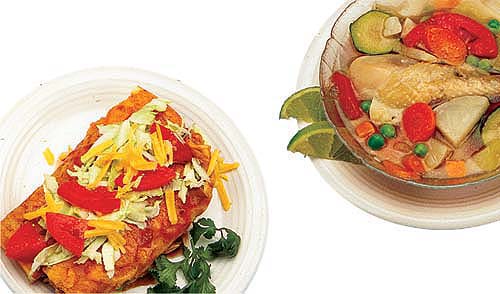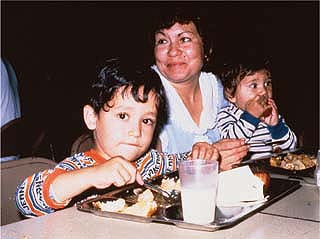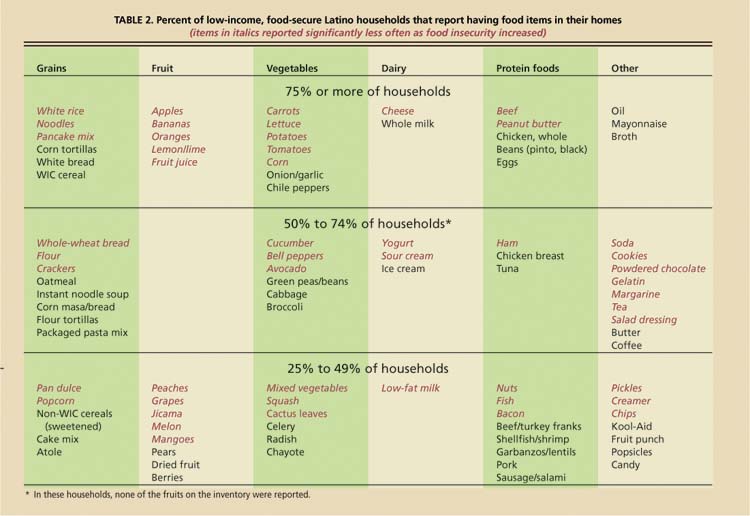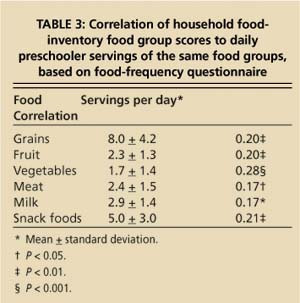All Issues
Food insecurity prominent among low-income California Latinos
Publication Information
California Agriculture 58(1):18-23. https://doi.org/10.3733/ca.v058n01p18
Published January 01, 2004
PDF | Citation | Permissions
Abstract
Food security is defined as access by all people at all times to enough food for an active, healthy life. In a study of 212 low-income Latino households in California, 45% were food insecure without hunger; 13% food insecure with moderate hunger; and 3% food insecure with severe hunger. Food insecurity was associated with a decline in household supplies of both nutritious and less nutritious foods. Among preschool children, the number of servings per day of all food groups was significantly correlated with household food supplies. A strong safety net to improve food security in low-income populations must include educational strategies and provision of nutritious foods to support a good diet at home and away from home.
Full text
People sometimes wonder whether hunger really exists in the United States, a land of plenty. Clearly, the phenomenon is different here than in many developing countries. “Food insecurity” is a relatively new concept that emerged in the early 1980s. Much of the research in the past 15 to 20 years has focused on developing a conceptual framework and instruments to measure the extent of the problem in this country. Little is known about the nutritional and health implications of the milder forms of food insecurity that are more common in the United States than severe hunger.
Food security is a relatively new concept for describing a person's access to enough food for an active, healthy life. In a study of low-income Latino families, preschool-age children had less to eat when household food stores were low. Above, a Yolo County girl learns to make tortillas.
Food security is defined as the access by all people at all times to enough food for an active, healthy life (Anderson 1990). At a minimum, food security includes: (1) the availability of nutritionally adequate and safe foods, and (2) the ability to acquire acceptable food in socially acceptable ways. Whenever the food supply or ability to acquire food becomes limited or uncertain, households are considered “food insecure” (Hamilton et al. 1997). “Hunger” refers specifically to the uneasy or painful sensation caused by lack of food. At a mild level of food insecurity without hunger, household members become anxious about their food supplies and begin to make adjustments in the type and amount of food purchased. When household members skip meals or otherwise cut back on the amount of food they consume, food insecurity with hunger occurs. At a moderate level of hunger, adult household members experience hunger. The most severe level of hunger is felt when the household's children are hungry.
Since 1995, the federal government has collected data annually on the prevalence of food insecurity and hunger in the United States using an 18-item Food Security Supplement (FSS) as part of the Current Population Survey (). This instrument is designed to detect different levels of food insecurity by the number of affirmative responses to the 18 items. Households are classified according to the number of affirmative responses: food secure (0 to 2); food insecure without hunger (3 to 7); food insecure with moderate hunger (8 to 12); and food insecure with severe hunger (13 to 18).
Although poverty and food insecurity are correlated, not all low-income households report being food insecure, partly due to the availability of food assistance programs and their informal support systems (Rose 1999). Similarly, sudden changes in employment status or the addition of a new member to the household may cause some households with higher income levels to be food insecure. Therefore, asking people directly about the adequacy of their household food supplies is important in monitoring the extent to which basic needs are met.
Latino households nationwide report higher levels of food insecurity than other ethnic groups. Focus groups in California found that seasonal food insecurity among low-income Latinos is related to fluctuations in jobs such as agriculture and construction labor. Above, families share snacks and meals.
Trends in food security and hunger
Data from the Current Population Survey indicates that the prevalence of food insecurity in California from 1996 to 1998 was higher than the national average (11.4% versus 9.7%)(Nord et al. 1999). As might be expected, the prevalence of food insecurity and hunger in California and the nation fluctuates in response to economic conditions. Between 1995 and 2000, food insecurity declined for most households and all regions of the United States, probably due to the improved economy (Andrews and Nord 2001). However, households with incomes less than 130% of the poverty level actually reported higher levels of food insecurity during the same time. Meanwhile, the use of emergency food pantries and kitchens also appeared to increase between 1996 and 2000 (Nord et al. 2003).
In 2001, the U.S. Department of Agriculture (USDA) Economic Research Service predicted that food insecurity would increase nationwide, reflecting the economic recession that began in 2001. In fact, their predictions were correct: the most recent USDA data reports that 11.1% of U.S. households were food insecure in 2002, up from 10.5% in 2000 (Nord et al. 2003).
Developed by federal agencies with input from more than 250 state health agencies and 350 national organizations, the Healthy People 2010 (2000) report included numerous national health and nutrition objectives, including the reduction of food insecurity by half. To achieve this objective by 2010, it will be necessary to improve employment and income opportunities for less-skilled workers and single mothers with young children, and to maintain a strong nutrition safety net.
Nutrition and health implications
Across diverse ethnic groups, food insecurity is associated with lower household supplies and consumption of fruit and vegetables (Kendall et al. 1996; Derrickson et al. 2001; Matheson et al. 2002). Intake of vitamin A, folate, iron, magnesium and zinc is particularly low among women in moderately to severely food-insecure households (Tarasuk and Beaton 1999). Intermittent episodes of food restriction due to financial constraints may actually lead to overeating at a later time when families have more money to spend. Research has found an association between food insecurity and overweight in women (Townsend et al. 2001; Olson 1999). Food insecurity has also been linked to emotional, psychological and academic problems in school-age children (Kleinman et al. 1998).
Food insecurity among Latinos
Latino households comprise a diverse and rapidly growing segment of the U.S. population and report relatively high levels of food insecurity compared to other ethnic groups (Alaimo et al. 1998; Nord et al. 2003). Focus group discussions in California revealed that many low-income Latino households experience seasonal cycles of food insecurity related to lack of agricultural and other employment such as construction during the winter (Melgar-Quiñonez et al. 2003).
Selected questions from 18-item Food Security Supplement of the Current Population Survey
Household-level food insecurity:
-
“We worried whether our food would run out before we got money to buy more.” (Was
that often, sometimes or never true for you in the last 12 months?)
-
“The food that we bought just didn't last and we didn't have money to get more.” (Was
that often, sometimes or never true for you in the last 12 months?)
Adult-level food insecurity (moderate hunger):
-
In the last 12 months, did you or other adults in the household ever cut the size
of your meals or skip meals because there wasn't enough money for food? (Yes, No,
Don't know/Refused)
-
In the last 12 months were you ever hungry but didn't eat, because you couldn't afford
enough food? (Yes, No, Don't know/Refused)
Child-level food insecurity (severe hunger):
-
(For households with children) In the last 12 months, did your child/any of the children
ever skip meals because there wasn't enough money for food? (Yes, No, Don't know/Refused)
-
(For households with children) In the last 12 months, did your child/any of the children
ever not eat for a whole day because there wasn't enough money for food? (Yes, No,
Don't know/Refused)
“We worried whether our food would run out before we got money to buy more.” (Was that often, sometimes or never true for you in the last 12 months?)
“The food that we bought just didn't last and we didn't have money to get more.” (Was that often, sometimes or never true for you in the last 12 months?)
In the last 12 months, did you or other adults in the household ever cut the size of your meals or skip meals because there wasn't enough money for food? (Yes, No, Don't know/Refused)
In the last 12 months were you ever hungry but didn't eat, because you couldn't afford enough food? (Yes, No, Don't know/Refused)
(For households with children) In the last 12 months, did your child/any of the children ever skip meals because there wasn't enough money for food? (Yes, No, Don't know/Refused)
(For households with children) In the last 12 months, did your child/any of the children ever not eat for a whole day because there wasn't enough money for food? (Yes, No, Don't know/Refused)
Note: The complete 18-item instrument and instructions for its use are at the USDA Food and Nutrition Service Web site: www.fns.usda.gov/fsec/FILES/FSGuide.pdf .
These households may be able to purchase traditional staples in bulk during the summer to use later but cannot afford certain perishable or other desired items during the winter. When households are anxious about their food supplies, homemakers often attempt to stretch a main dish and allocate a little less to all family members. In some situations, the mother may cut back on her own food intake first, attempting to spare both the adult male wage earner and the youngest children.
In a California study conducted among 238 Mexican American households during winter 1998, food insecurity was significantly associated with higher intakes among preschoolers of beans and tortillas and lower intakes of low-fat milk, cooked vegetables, pizza, cookies, crackers and other desserts (Kaiser et al. 2002). Overall, the diets of preschoolers in severely food-insecure households were less likely to meet the USDA Food Guide Pyramid recommendations, compared to more food-secure households. These findings demonstrate that cyclical patterns of food insecurity are associated with a less varied diet. More studies are needed to determine whether permissive attitudes about snacking and food selection, following periods of anxiety and food restriction due to seasonal food insecurity, might contribute to greater consumption of high-fat and/or high-sugar foods among Latino children.
When household food supplies are low, mothers may cut back on their own intake so that young children are not hungry.
The household inventory included foods used in traditional Mexican meals, above, such as tortillas, rice and beans, and avocados.
UC Cooperative Extension research
The UC Cooperative Extension (UCCE) Body Weight and Health Workgroup recently conducted a study related to food insecurity and overweight among 561 Latino families ( see page 12 ). The study was a cross-sectional survey of low-income households (administered at one time to all subjects), carried out between February and May 2001, in six California counties. They included rural counties on the coast or in the Central Valley (Tulare, San Benito, San Joaquin, Stanislaus) and urban counties (Contra Costa, Sacramento). This paper focused on a subset of 212 families, randomly selected to provide additional dietary data. The objectives were to examine the impact of food insecurity on household food supplies and preschooler food patterns, and discuss the implications for strengthening the nutrition safety net.
The survey included the 18-item U.S. Household Food Security Scale (FSS) (Bickel et al. 2000); a 171-item self-reported household food inventory (Beto et al. 1997); and a 66-item food frequency questionnaire (Kaiser et al. 2002). To improve the clarity of the research instruments we conducted focus group testing; pilot-testing among 20 low-income Latino families recruited through the Special Supplemental Nutrition Program for Women, Infants, and Children (WIC); and crosschecking of the final translated instrument by eight native Spanish speakers from Mexico, Central America and South America.
To be eligible for this study, participants had to meet the following criteria: (1) mother identified herself and her child as Latino, Mexican or Hispanic; (2) mother had at least one biological child born between June 1, 1995, and Feb. 1, 1998; (3) family had income at or below 200% of poverty level; (4) mother was 18 years or older (or an emancipated minor); and (5) subject was willing to sign the Human Subjects consent form approved by the UC Davis Institutional Review Board. People were excluded for any of the following: mother was currently pregnant or pregnant within the last 3 months; mother planned to move within the next 2 weeks; interviewer perceived or mother reported alcohol or substance abuse, mental illness or other illness that could affect accurate responses, body weight or diet. If the family had more than one eligible child between 3 and 6 years old, interviewers randomly selected the target child by coin toss.
For the study of 561 families, interviewers recruited a convenience sample from community-based agencies including WIC, Head Start, migrant camps, the local public health department, local health centers and family resource centers. Some interviews were conducted in the subjects' homes, but most took place in private rooms in health or WIC clinics. Interviews were conducted in English or Spanish, depending on the subject's preference. Interview length was 45 to 60 minutes. At the end, the subject received a gift certificate worth $20 at a local store.
We used the Food Guide Pyramid recommendations to calculate the number of servings per week from each food group (USDA 1999). In addition to the five main food groups, another category included daily servings of snack foods (cookies, crackers, candy, popsicles, ice cream, hot dogs, cheese). These foods were selected based on findings from focus group discussions about preschooler snacking behavior in a previous study among Latino parents (Kaiser et al. 1999). To examine the relationship of food insecurity and household food supplies, we created scales for several food groupings, including grains, dairy, meats, vegetables, fruits and snack foods. Each food item was assigned a score: “1” if present in the household at the time of the interview or “0” if not present. Scores for all food items within a food group were summed across the items.
TABLE 2. Percent of low-income, food-secure Latino households that report having food items in their homes (items in italics reported significantly less often as food insecurity increased)
The data was analyzed using SAS version 8.01 (SAS Institute, Cary, N.C., 1999-2000). Statistical tests included Pearson's product-moment correlation coefficient, analysis of variance and chi-square. Since the food intake data was not normally distributed, we used a logarithmic transformation of those variables in the analysis. Of the 274 families interviewed, complete data on food insecurity, household food supplies and child food patterns was available for 212 (table 1).
Of the 212 families studied, 39% were food secure; 45% food insecure without hunger; 13% food insecure with moderate hunger; and 3% food insecure with severe hunger. The sample was largely composed of less acculturated families, on the basis of preferred language (76.9% spoke mainly Spanish at home). Since a convenience sample was recruited for the study, the findings presented should not be generalized to the Latino population at large.
Impact on household food supplies
Food insecurity was associated with a decline in household supplies of both nutritious and less nutritious foods (table 2). For example, some nutrientdense foods reported less often as food insecurity increased included oranges, apples, bananas, lemons, tomatoes, carrots, beef, fish and whole-wheat bread. A few less nutrient-dense foods, including soda, cookies, chips, powdered-chocolate flavoring and gelatin, were also reported less often as the level of food insecurity increased. Core foods — or those appearing in 90% or more of the households reporting food insecurity with hunger — remained stable and included corn tortillas, white rice, onions, beans and cooking oil (Kaiser et al. 2003). An important point for nutrition educators is that a number of high-fat and/or high-sugar foods also showed no change as the level of food insecurity increases; these included hot dogs (beef/turkey franks), sweetened (non-WIC) cereals, ice cream, candy and fruit-flavored punches.
The main source of food assistance in this sample was the WIC program (less than 10% reported using food pantries or other emergency food sources). Neither WIC nor food stamp participation was correlated with food security. This finding might be due to the nature of this cross-sectional study; a longitudinal design examining pre- and postenrollment food security status might yield a different picture. Also, our findings were basically unadjusted for several other unmeasured factors that may have influenced the decision to participate in those programs and confounded the results. WIC did not have an effect on specific household food items, even for the types of foods provided by WIC such as juice, milk, peanut butter, beans, cereal and eggs. However, WIC participation had a positive effect on the overall household inventory score for fruit (WIC households had 6.9 fruit items, versus 5.7 items in non-WIC households: P = 0.04). Having WIC coupons to cover some basic necessities may enable people to use the extra money saved to buy more fruit. Alternatively, WIC education may influence food-insecure households to purchase more fruit.
TABLE 3: Correlation of household food-inventory food group scores to daily preschooler servings of the same food groups, based on food-frequency questionnaire
Children's eating patterns
As might be expected, a limited supply of foods in the household is correlated with lower child intake of those foods (table 3). For example, the number of different vegetables available in the household was significantly correlated with preschooler daily intake of vegetables (r = 0.28, P < 0.001). A similar relationship was found for other food groups. Even though parents may attempt to shield young children from hunger, preschooler food patterns are affected by changes in the household food supply. These changes may have important implications not only for current health status but also the long-term development of good eating habits in these children. For example, research has shown that role modeling and repeated exposure to new foods is necessary to help children develop a preference for those foods (Birch and Marlin 1982). Limited household supplies of fruit and vegetables may reduce opportunities to learn to enjoy a variety of foods.
Schools and other programs providing food to low-income children should offer a wide variety of healthy foods that may not be available at home, especially fresh fruit and vegetables.
The food safety net
Although the most commonly reported foods in this study are similar to those reported by Latino families elsewhere (Beto et al. 1997), findings from our study, with its convenience sample, may not apply to other Latino groups. Emergency food providers should always check with their own clientele regarding the types of foods to provide. As a starting point, emergency food providers could focus on ways to provide commonly used foods that are most vulnerable to change in food-insecure households, such as fruits and vegetables including carrots, oranges, tomato products and apples. Other basic food supplies like flour, rice, pasta and beef might also be considered. On the other hand, supplies of some traditional items like corn tortillas and beans may already be adequate in the household stores and not necessary to provide through pantries.
Nutrition educators may also find the listing of foods in table 2 helpful in designing nutrition education programs. In our focus groups, migrant farmworkers identified lack of nutrition knowledge as a factor contributing to food insecurity. It is important to educate Latino families about the nutritional benefits of inexpensive, traditional foods, such as beans, corn tortil-las, lentils, oatmeal and cactus leaves. Educators should provide appealing recipes, making use of the foods most commonly found in food-insecure households. They can also increase awareness that certain inexpensive foods — such as hot dogs, instant noodle soups and fruit-flavored punch — have limited nutritional value. This education should be handled in a variety of settings, including the Expanded Food and Nutrition Education Program (EFNEP), the Food Stamp Nutrition Education Program (FSNEP), WIC, Head Start and other community programs.
Head Start, day-care centers and schools serving this population should offer menus that include a wide variety of nutritious foods commonly found in Latino homes. Since food-insecure families rely heavily on traditional foods at home, they may expect child care and school feeding programs to provide their children with foods that appear unaffordable to the family, especially fresh fruit, vegetables and meat. While nutrition programs are critical in providing children with access to healthful foods, they cannot replace parental role modeling and the home in the development of long-term eating patterns.
Although 78% of our study participants were enrolled in the WIC program, even more may have been eligible. Moreover, only 25% were receiving food stamps. Federal food-assistance programs should develop more effective outreach and enrollment efforts to improve food security in this population.
In summary, food insecurity in Latino households is associated with a decline in household supplies of both nutritious and less nutritious food. In turn, household food supplies are correlated with preschooler food intakes in these families. A strong safety net must include strategies, through education and provision of nutritious foods, to support nutrition both inside and outside the home.



